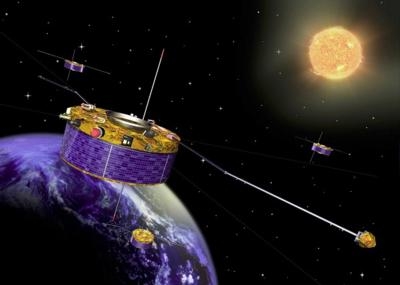Mon, Sep 30, 2013
Four Identical Spacecraft Have Been Studying The Earth's Magnetospehere In Three Dimensions
Since 2000, the four identical satellites of the Cluster quartet have been probing Earth’s magnetosphere in three dimensions. This week, two of them made their closest-ever approach, just two-and-a-half miles, enabling valuable data to be acquired with unprecedented detail.

In an orbital reconfiguration that will help to maintain the mission’s life span, two of the four satellites achieved their closest-ever separation on 19 September, closing to within just 2.5 miles of each other as they orbited at up to 14,000 mph high above Earth. “We’re optimizing the Cluster formation so that the separation between Cluster 1 and the duo of Cluster 3 and 4 – which are on almost identical orbits – is kept below 62 miles when the formation crosses Earth’s magnetic equator,” says Detlef Sieg, working on Cluster flight dynamics at ESA’s ESOC operations centre in Darmstadt, Germany.
The formation will hold three of the four satellites close together at lower altitudes, optimizing the range of science observations. “Following the closest-ever approach on 30 August, we achieved a new mission record with C1 and C3 (September 19), at just 4 km (2.4 miles) around 0912 GMT,” says Juergen Volpp, Spacecraft Operations Manager at ESOC.
The main challenge in achieving the formation was to exclude any collision risk and to avoid further maneuvres, which would interrupt science activities. “We can determine the satellites’ orbits with an accuracy better than 0.1 km (328 feet),” says Detlef Sieg, “so we knew we could achieve the formation with sufficient allowance for safety.”
The new formation will be held until early November before the separations are increased to more than 621 miles. “When we started Cluster, we believed that a separation of 500 km 310 miles) was the smallest required by science,” says ESA’s Phillipe Escoubet, Cluster Mission Scientist. “However, it turns out that the physical processes at very small scales are very important and this is why we have decided to decrease the separation distance to more than a factor 100 to just 4 km (2.4 miles), as it will allow us to study electromagnetic waves in the radiation belts with unprecedented detail.”
(Image provided by ESA)
More News
Very High Frequency The frequency band between 30 and 300 MHz. Portions of this band, 108 to 118 MHz, are used for certain NAVAIDs; 118 to 136 MHz are used for civil air/ground voi>[...]
Aero Linx: Aviation Suppliers Association Established February 25, 1993, the Aviation Suppliers Association (ASA), based in Washington, D.C., is a not-for-profit association, repre>[...]
Have A Story That NEEDS To Be Featured On Aero-News? Here’s How To Submit A Story To Our Team Some of the greatest new stories ANN has ever covered have been submitted by our>[...]
From 2021 (YouTube Version): Colorado Campus Offers aVariety Of Aerospace Entertainment And Education Wings over the Rockies Exploration of Flight is the second location for the Wi>[...]
Also: Paramotor Champ's, Electric Ultralight, ICON BK Update, Burt Rutan at Oshkosh! The Popular Rotorcraft Association is reaching out for help in rebuilding their private runway >[...]
 ANN's Daily Aero-Term (05.17.24): Very High Frequency
ANN's Daily Aero-Term (05.17.24): Very High Frequency ANN's Daily Aero-Linx (05.17.24)
ANN's Daily Aero-Linx (05.17.24) ANN FAQ: Submit a News Story!
ANN FAQ: Submit a News Story! Classic Aero-TV: ANN Visits Wings Over The Rockies Exploration Of Flight
Classic Aero-TV: ANN Visits Wings Over The Rockies Exploration Of Flight Airborne Affordable Flyers 05.16.24: PRA Runway, Wag-Aero Sold, Young Eagles
Airborne Affordable Flyers 05.16.24: PRA Runway, Wag-Aero Sold, Young Eagles



